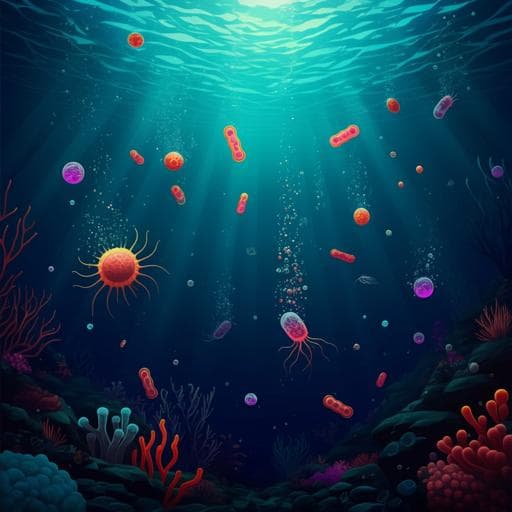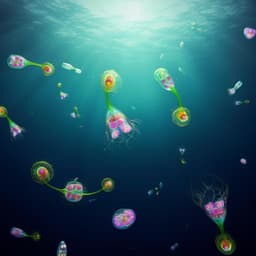
Earth Sciences
Microbes contribute to setting the ocean carbon flux by altering the fate of sinking particulates
T. T. H. Nguyen, E. J. Zakem, et al.
Discover how microbial dynamics impact the vertical flux of particulate organic carbon in our oceans. This groundbreaking research by Trang T. H. Nguyen and colleagues explores the complex interactions that control carbon transfer to depths, revealing crucial insights for global carbon cycling and climate predictions.
~3 min • Beginner • English
Introduction
The study addresses how particle-associated microbial dynamics shape the vertical flux and attenuation of particulate organic carbon (POC) in the ocean. While prior large-scale models have primarily emphasized physical and chemical controls (particle size spectra, lability, temperature), they generally omit explicit microbial ecological processes, despite microbes and grazers controlling many of those mechanisms. Observations indicate rapid microbial growth on particles and substantial microbial contributions to remineralization, yet labile particles persist at depth, posing a paradox. The authors hypothesize that depth-dependent microbial processes—such as enzyme production, attachment/detachment, mortality, and density-dependent colonization—govern variability in POC consumption and flux attenuation. The purpose is to mechanistically integrate micro-scale microbial behaviors into a water-column model to reconcile fast microbial growth with slow bulk remineralization rates and to quantify microbial impacts on large-scale POC flux profiles.
Literature Review
Decades of work have shown POC flux depends on surface production, sinking speed, and subsurface consumption. Large-scale models capture roles of particle size spectra, lability, and temperature but typically use tuned, low, invariant POC consumption terms without explicit ecology. Empirical and lab studies demonstrate that heterotrophic microbes account for a major fraction (70–92%) of remineralization; grazers mediate aggregation/disaggregation and consumption, influencing particle size and sinking. Microbial communities on particles can grow rapidly (1–10 d−1) and degrade POC on day timescales, yet labile particles are found in deep waters. Prior explanations include temperature and pressure limitations on microbes. Micro-scale studies highlight enzyme kinetics, attachment/detachment, mortality, and a critical density (Allee effect) required to overcome diffusive loss of enzymes and hydrolysis products, implying that apparent lability is an emergent ecosystem property depending on microbial enzymes, organic matter chemistry, and environment. Conventional representations with constant remineralization are therefore inadequate to capture observed variability.
Methodology
The authors develop a mechanistic water-column model that scales micro-scale particle–microbe interactions to oceanic POC fluxes. Key features: (1) Particles initialized between 50–100 m with observed particle size distributions (power-law exponents s = −2, −3, −4). No new particle formation is allowed below the export depth. (2) Each particle is stochastically assigned an initial radius, a single lability parameter β (polymer-to-LMWOM conversion rate), and colonized by a single microbial group; 18 heterotrophic microbial groups (with distinct enzyme kinetics and growth rates) represent particle-associated diversity. Sensitivity tests with multiple groups per particle and more groups show similar POC flux profiles. (3) Colonization proceeds as particles sink, with encounter rates depending on particle size, sinking speed, and depth-dependent free-living microbial abundances (exponentially decreasing with depth). (4) Particle sinking speed depends on size and specific gravity; particle radius shrinks as POC is degraded, reducing sinking speed. (5) Microbial growth depends on locally produced low-molecular-weight organic matter (LMWOM) created by extracellular enzymatic hydrolysis of POC; LMWOM is subject to diffusive/advective loss from the particle surface. Temperature dependence of growth is applied using a typical ocean temperature profile. (6) The model reproduces density-dependent colonization with a critical threshold (Allee effect) arising from mortality, detachment, and solute losses, determining whether populations achieve exponential growth on a particle. Governing equations (per particle i): dCPOC_i/dt = −β_i B_i; steady-state LMWOM concentration C_LMWOM ≈ (β_B μ_B y_B)/d_L; microbial biomass dynamics dB/dt = (μ_B − m_B − L)B + E_B; Monod growth μ_B = Vmax,B C_LMWOM / (K_m,B + C_LMWOM), with temperature limitation; and total POC flux F(z) is the sum over sinking particles’ contributions at depth z. (7) Stochastic simulations: a 2.24 m × 2.24 m water column with total initial POC flux ~1.5 mol C m−2 yr−1; particle counts range from 2,256 (s = −2) to 763,615 (s = −4), radii 50 μm to 0.4 cm. Parameters sampled uniformly within ranges (except β, log-normal): Vmax (maximum growth) 1.2 or 7.2 d−1; β spanning ~10−1 to 1000 mmol CPOC mmol Ccell−1 d−1; initial cell density 400–2,800 cells mm−3; free-living cell density 10−1–285 cells mm−3. Each parameter set is run in 1,000 stochastic realizations for up to 600 days (sufficient for full consumption or export >4,000 m). POC flux attenuation is quantified via F = F100·10^{b z}, estimating b by least-squares fit.
Key Findings
- The model captures observed density-dependent growth on particles, with a critical surface-density threshold required for successful colonization; below this, loss processes (mortality, detachment, diffusive/advective solute loss) prevent establishment.
- Particle degradation timescales vary widely due to interactions among lability, particle size, microbial biomass at formation, temperature, and encounter rates: approximately 5 days to >200 days, with most particles persisting a few weeks (~30 days, lognormal) below the export depth, consistent with observations.
- For a representative case (initial radius 500 μm, lability 32 mmol CPOC mmol Ccell−1 d−1), about half of particles are consumed above 1,000 m while the other half persist to >2,000 m, depending on stochastic microbial assembly and encounters.
- Two dynamic regimes emerge: (i) successful colonization leading to rapid exponential growth and shallow remineralization (upper ~500 m), and (ii) struggling communities failing to surpass the threshold, yielding slow consumption and greater deep transfer. Intermediate cases can be “rescued” by additional colonizers encountered en route.
- The dichotomy between fast and slow remineralization emerges mechanistically from microbial dynamics, explaining phenomenological two-lability or double-exponential flux models. Lability is an ecosystem property, not solely chemical.
- A depth-dependent shift in particle-associated community composition is predicted: fast-growing, high-lability-associated taxa dominate near the surface; slower-growing taxa become relatively more abundant at depth; diversity is higher in surface waters, aligning with observations.
- Temperature modulates outcomes by limiting growth for struggling populations but is not the primary driver when exponential growth is achieved; global correlations between attenuation and temperature may reflect co-varying lability and community function.
- Variability in microbial parameters (lability, maximal growth rate, encounter rate) can alter POC attenuation to a degree comparable to shifts in particle size spectra. Modeled attenuation exponent b distributions across 10,000 simulations match the range and distribution from 897 global UVP-derived observations (1–30% of initial flux remaining at 1,000 m), reproducing regional variability without invoking additional processes.
- The model suggests microbial community state and stochastic assembly can generate the long tail of deep POC persistence (>1,000 m) and that small shifts in microbial dynamics can rapidly change export efficiency.
Discussion
By explicitly resolving micro-scale colonization, enzymatic hydrolysis, and density-dependent growth on sinking particles, the model explains how microbial dynamics shape the vertical POC flux. Communities that fail to overcome losses produce slow remineralization and elevated deep transfer, whereas modest increases in initial biomass, encounter rates, or lability can push communities past the threshold, causing rapid shallow remineralization. This mechanism reconciles fast microbial growth potentials with slow bulk remineralization profiles and offers an alternative explanation for pulsed export in oligotrophic regions: communities not primed for large-particle degradation (lower biomass/encounters) allow more efficient deep transfer during episodic export events. The findings highlight microbial controls as being as influential as particle size spectra in setting attenuation, and they contextualize observed relationships with temperature as being mediated by ecosystem composition and substrate quality. Although processes like zooplankton grazing, aggregation/disaggregation, and in situ particle formation also influence fluxes, the presented framework isolates and quantifies microbial contributions, generating testable predictions on community thresholds, composition with depth, and sensitivity of flux to microbial parameters.
Conclusion
The study integrates micro-scale particle–microbe processes into a scalable water-column model, demonstrating that microbial dynamics alone can generate the observed variability in POC flux attenuation across the global ocean. It shows that lability is emergent from interactions among microbial communities, organic-matter chemistry, and environment, and that stochastic assembly can produce either rapid shallow remineralization or persistent deep POC. The model reproduces global attenuation patterns and provides mechanistic hypotheses for regional and temporal variability, including pulsed export events. Future research should couple this framework with zooplankton dynamics, aggregation/disaggregation, and in situ particle formation, and should be guided by targeted field and laboratory measurements of key microbial processes (e.g., encounter, detachment, growth efficiency, enzyme activity, loss rates) to better constrain parameters and improve prognostic skill in carbon-cycle and climate models.
Limitations
- The model omits explicit zooplankton processes (grazing, fragmentation, vertical migration) and particle aggregation/disaggregation, which can significantly alter particle size and flux.
- No new particle formation is allowed below the export depth; only degradation is represented in the water column.
- Each particle is simplified to a single lability class and colonized by one microbial group, although sensitivity tests suggest bulk flux results are robust.
- Parameter uncertainties remain high for encounter rates, detachment, mortality, bacterial growth efficiencies, and enzyme kinetics; lability distributions are poorly constrained by observations.
- Temperature dependence is prescribed and may not capture all physiological and pressure effects in the deep sea.
- The modeling domain represents an idealized column and does not include lateral transport or heterogeneity in physical conditions beyond the imposed profiles.
Related Publications
Explore these studies to deepen your understanding of the subject.







